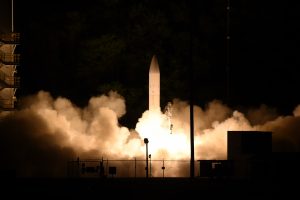Last week I wrote about a specific application of machine learning – a way to make weapons smarter, to simplify somewhat. But adding intelligence is not the only way in which we are likely to see the tools of warfare evolve. There is a parallel arms race to make weapons much faster, but the extent to which one trend drives the other is complicated by their very different developmental challenges.
Last week also saw the Indian Defence Research and Development Organisation (DRDO) announce its first test of a new hypersonic vehicle. India joins a rowing race to build and deploy the fastest rockets and missiles; the U.S., China, Russia and Europe are already investing heavily.
It’s important to note that “hypersonic” weapons (weapons with speed greater than five times that of sound) include two separate categories and exclude another. The excluded category are standard ballistic missiles, which vastly exceed “hypersonic” speeds as they plunge through the atmosphere towards their targets – but which follow a predictable and basically immutable trajectory as they do. There are hypersonic cruise missiles, which would fly through the atmosphere powered by scramjets, and there are hypersonic glide bodies, which are boosted up to immense speed on conventional rockets but instead of arcing through space ride on their own shockwave through the upper atmosphere. In both cases, the advantage is that a weapon could follow a lower trajectory (reducing its visibility to long-range radar) and potentially maneuver to obscure its target and avoid countermeasures.
The disadvantage, of course, is that making a weapon capable of surviving the extraordinary heat and stresses of hypersonic flight – let alone maneuvering accurately under those conditions – requires an extremely high degree of precision along with incredibly sophisticated metallurgy. This complexity accounts for why the first operational hypersonic weapons have only been deployed in the last few years. And with no publicly-known combat use yet and relatively little test data available in the public domain, it is impossible to assess the degree to which they are effective.
If such systems do become effective and widespread, however, a number of strategic and tactical dilemmas immediately emerge.
Consider, for example, the question of defending against a hypersonic-armed adversary. In principle, effectively unstoppable weapons already exist in the form of intercontinental ballistic missiles (ICBMs). But ICBMs are both expensive and inaccurate enough that they are exclusively relegated to a strategic nuclear strike role, and plans to add conventional strike missions have always foundered on the risk of prompting a nuclear response to a non-nuclear strike.
Hypersonic weapons are likely to enter a much more febrile world environment; instead of two relatively closely matched adversaries locked into mutually assured destruction, they may enter arsenals of a half-dozen major military powers just as the post-Cold War unipolar moment gives way to a much more unstable arrangement. And as they do, they will create a multifaceted security dilemma.
That dilemma is driven at a fundamental level by questions of response time. Existing missile defense systems are already at the limit of what human response time can accommodate; for a projectile moving three to five times faster, there simply would not be time for a human operator to assess the threat and clear the system to engage before it was too late. But the alternative – full automation – creates operational, legal and ethical complications which are far from resolved.
And that problem is compounded at the strategic level, not least because long-range hypersonic systems pose a discrimination problem: a hypersonic projectile might have a conventional payload, or it might be nuclear-tipped. An exchange of ICBMs between the U.S. and USSR was generally calculated to take roughly 30 minutes, leaving less time for heads of state to make a decision that could end civilization as we know it than it has taken you to read this article. A switch to hypersonic delivery systems and a mixture of nuclear and conventional roles would add another layer of confusion to an already perilous system of mutual deterrence – and automating the decision to launch retaliatory nuclear strikes is, and should remain, the stuff of dystopian science fiction.
It is worth reiterating that in the public sphere there is still an enormous ambiguity about the actual reliability and combat effectiveness of hypersonic weapons; there are certainly abundant historical examples of militaries rushing immature systems into “operational” status for political advantage. But by the same token, hypersonic weapons sit at the intersection of rapid and unevenly distributed technological change, a changing global power balance, and fundamental questions over how we understand and control the use of force. We should wait for more evidence before declaring them a game-changing technology; but we should also not dismiss the possibility that the evidence may arrive sooner than expected.

































